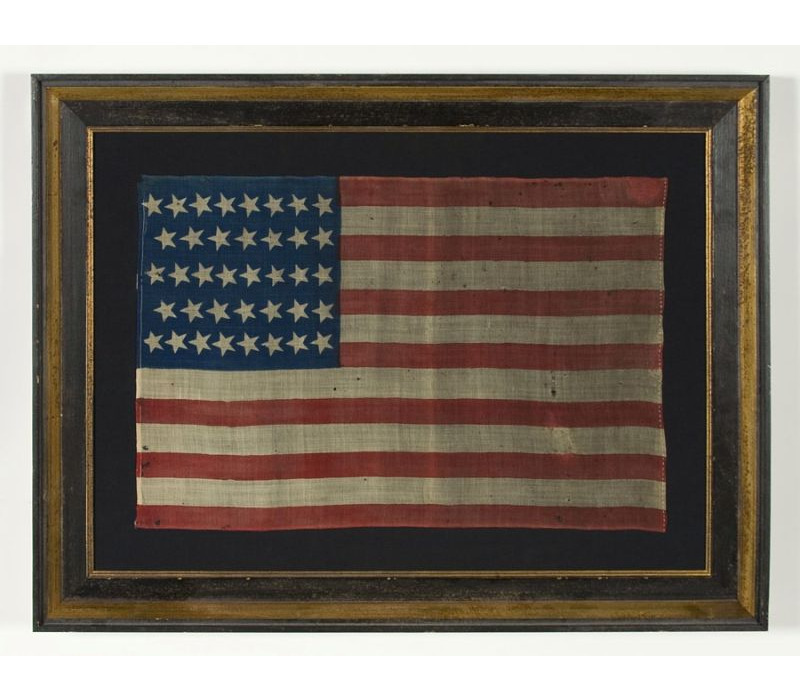
| |
38 STARS, COLORADO STATEHOOD, A PRESS-DYED WOOL FLAG MADE FOR THE 1876 CENTENNIAL INTERNATIONAL EXPOSITION IN PHILADELPHIA AND SOLD BY HORSTMANN BROTHERS |
|
| Available: |
Sold |
| Frame Size (H x L): |
31" x 40" |
| Flag Size (H x L): |
20" x 29" |
|
| Description....: |
|
38 STARS, COLORADO STATEHOOD, A PRESS-DYED WOOL FLAG MADE FOR THE 1876 CENTENNIAL INTERNATIONAL EXPOSITION IN PHILADELPHIA AND SOLD BY HORSTMANN BROTHERS:
38 star American national parade flag, press-dyed on wool bunting. The stars are arranged in lineal rows of 8-7-8-7-8, all of which are justified to the fly-end side of the blue canton. This justification of the offset rows is an unusual variation. Note how each star is canted in the 11:00 position, which results in an appearance that is unlike that of present day Stars & Stripes.
This flag was made for Horstmann Brothers (also called Horstmann & Sons at one time) in Philadelphia, a major military outfitter. Horstmann did not make their own flags, but put their name on many of the things they sold. This flag does not have the traditional Horstmann stencil, but it was found in the Philadelphia area, rolled up with a group of flags representing both the U.S. and various other nations. The Centennial International Exposition, a major World's Fair event, took place in Philadelphia. The Horstmann mark was on almost, but not all of the flags. All but one (a pieced-and-sewn French flag) were of the same basic size and press-dyed wool construction and it was obvious that all were produced by the same maker. All were on the same staffs and were certainly acquired from Horstmann.
The 38th state, Colorado, received its statehood on August 1st, 1876. This was just 28 days after the official centennial celebration, which took place on July 4th. Although 37 was the official star count in 1876, flag-making was a competitive venture, and no one wanted to be making 37 star flags when others were making 38's. It is for this reason that 38 and 13 (to reference the original 13 colonies) are the two star counts most often seen at the centennial celebration. The 38 star flag was generally used until 1889, when four new states joined the Union.
Press-dyed wool flags are rarer than those printed on cotton and silk. Most parade flags were made of cotton, because cotton was inexpensive and such flags were often intended for one day's use only at a specific parade, political rally, a reunion of soldiers, or some other patriotic event. The Centennial Exposition lasted for six months, requiring decorative flags that would last for a longer period. It is reasonable to assume that press-dyed wool flags were made for just such a purpose, because wool sheds water is more appropriate than cotton for extended outdoor use.
First patented in 1849, the press-dying process was initially thought to be a novel idea that would improve flag-making efficiency. The reality, however, was that it was often less effective and efficient than sewing. To achieve white stars, for example, pieces of waxed fabric or paper in the shape of stars had to be cut out and carefully placed on both sides of the white wool bunting. The bunting was then dyed blue, and when done properly, the areas where the material was placed would not absorb the dye and thus be left white. The same process was repeated to make the red stripes. Also called resist-dyeing, one can imagine why this task may have been anything but simple with 19th century technology.
This inexact art would often add crude characteristics, such as stripes with irregular lines, in various widths, and stars with inconsistent shapes, in slightly varying sizes. It is likely that this resulted in lost product and wasted time, from flags that had bleeding or misprint issues and were of too poor quality to sell. But within those flags that survived, today's collectors today find the irregularities interesting, not only because they demonstrate early production methods, but also because they lend the sort of folk qualities that make early flags more interesting to look at.
Mounting: The flag has been hand-stitched to 100% silk for support. It was then hand-sewn to a background of 100% cotton twill, black in color, which was washed to remove excess dye. An acid-free agent was added to the wash to further set the dye and the fabric was heat-treated for the same purpose. The mount was then placed in a black-painted and hand-gilded, contemporary Italian molding. The front is u.v. protective plexiglas.
Condition: There is a moderate hole at the extreme fly end of the topmost stripe and another in the 5th white stripe, near the fly end. Fabric of similar coloration was placed behind these areas for masking purposes. There are also much smaller losses throughout. There is moderate foxing and staining, especially in the fly end half of the flag. The flag presents nicely, however, and many of my clients prefer early flags to show their age and history of use. |
|
|
|
| Collector Level: |
Intermediate-Level Collectors and Special Gifts |
|
| Flag Type: |
Parade flag |
|
| Star Count: |
38 |
|
| Earliest Date of Origin: |
1876 |
|
| Latest Date of Origin: |
1876 |
|
| State/Affiliation: |
Colorado |
|
| War Association: |
1866-1890 Indian Wars |
|
| Price: |
sold |
|
| |
Views: 3799 |
|
|
|

